Responsibility, modularity, transparency: these are some of the key themes characterising the production of Flavia La Rocca, a fashion designer basing her research on modular items of clothing and sustainable fabrics, also from the perspective of a circular approach to fashion. Ethics and aesthetics are associated not only because they rhyme, but also as elements distinguishing the collections of the brand, named after the designer herself. We have interviewed Flavia, embarking with her on a journey that has led us to discover – step by step – the various stages in the development of her artistic and professional career, and the peculiarities and the “behind the scenes” of her clothes.
Let’s start from the past. Flavia, where did the idea of becoming a fashion designer come from?
From my childhood, at home. My mother has always sewn as a hobby, so as a small child I was already used to seeing clothes being created from scratch, from the pattern to the assembled piece to the finished item. So when it came to starting university I chose to study in this sector I found so fascinating. I enrolled in the faculty of Sciences of Fashion and Costume at the Sapienza University of Rome, specialising in economy-management to develop a wider set of skills. A month after graduating I started my first internship in the press office of Blumarine, the beginning of a series of collaborations with important brands, until the launch of my own in 2012.
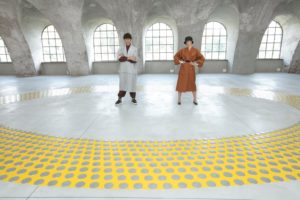
Habitus, Abito, Abitare: Flavia La Rocca, Cittadellarte Fashion B.E.S.T. (with Lanificio F.lli Cerruti as technical sponsor). The items of clothing were made by the social cooperative Sartoria È. Picture taken in the permanent home of the Third Paradise.
Sustainability is a key aspect of your clothes. What does it represent for you? Can you tell us about the peculiarities of your production?
In my work, sustainability is the crucial element, from conception to realisation. I never design standard items, but interchangeable modules that can be disassembled and reassembled using hidden zips, generating multiple combinations. Modules of the same size from different collections can be mixed to create an endless and always renewable wardrobe. My production is based on sharp and geometrical lines with a feminine attitude, a dialogue between seasonal perspectives and a timeless, modern and functional design. What I am trying to do is proposing a new interpretation of the concept of making clothes: a responsible, dynamic and modern way to dress.
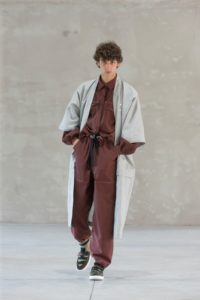
Habitus, Abito, Abitare: Flavia La Rocca, Cittadellarte Fashion B.E.S.T. (with Lanificio F.lli Cerruti as technical sponsor). The items of clothing were made by the social cooperative Sartoria È.
What ethical advantages does modularity offer?
By allowing the creation of more combinations with the use of only few pieces, modularity decreases the quantity of raw materials and energy employed, and the environmental impact of the production process. It also extends the life cycle of the product since this is generally kept in one’s wardrobe for longer because continually renewable. In addition to this, the materials with which I make my collections are always sourced according to the highest standards of sustainability and innovation with the lowest possible environmental impact. The ethical production entirely made in Italy reduces the negative repercussions on the environment of transport and CO2 emissions.
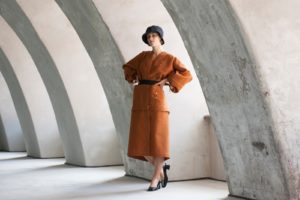
Habitus, Abito, Abitare: Flavia La Rocca, Cittadellarte Fashion B.E.S.T. (with Lanificio F.lli Cerruti as technical sponsor). The items of clothing were made by the social cooperative Sartoria È. Picture taken in the permanent home of the Third Paradise.
Together with other fashion designers, you are working on responsible productions, proving that ethics and aesthetics can coexist. How can sustainability be made affordable to a larger section of the population, from young people to less wealthy families?
Through the shortest possible supply chain: reaching the final consumers directly helps us better manage our relationship with them and control the prices in order to make the product more accessible. Unlike big international companies, for small businesses like mine and my designer colleagues’, the production costs are very high, especially because we are very keen on respecting a series of standards of ethicality and of types of raw materials.
The 2013 Dhaka garment factory collapse is considered by many to be the tragedy that stirred the waters in the sustainable fashion sector, starting from production. In the aftermath of that dramatic – and not isolated – episode, what do you think is the right instrument to raise social awareness on the theme making consumers responsible and attentive?
We have to inform. A lot of people don’t know what’s behind an item of clothing, who made it and how, what’s made of, where it comes from and above all if it’s good or bad for them. This is obviously because people not working in the sector are not that particular about it. I think that it is important that this type of information reaches everybody so that they can consciously choose what to buy and where, besides being aware of what environmental impact their choice will have.
You’ve been collaborating with Cittadellarte’s Fashion Office for a long time. What does the project Fashion B.E.S.T. represent to you??
It proves that joining forces you can trigger change and it represents the true sense of working on a common objective. A designers collective working on shared projects, exchanging information and helping each other is something new, but our mission is to inform and educate together, to inspire and spread a responsible and circular approach to fashion combining ethics and aesthetics. The objective is therefore to generate a force of change turning the utopia of responsible fashion into the new standard. Also, Cittadellarte is a magical place where Michelangelo Pistoletto’s art assumes social responsibility and acts as the common thread across all the activities.
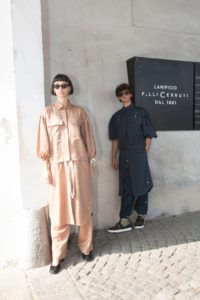
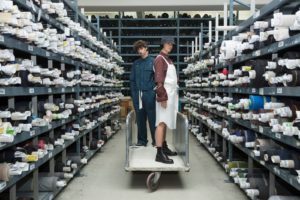
Habitus, Abito, Abitare: Flavia La Rocca, Cittadellarte Fashion B.E.S.T. (with Lanificio F.lli Cerruti as technical sponsor). The items of clothing were made by the social cooperative Sartoria È. Picture taken at Lanificio F.lli Cerruti.
You did in fact play a key role in the Terme Culturali with Habitus-Abito-Abitare and you are one of the designers working on CirculART. Can you tell us more about your active participation in these projects?
For the Terme Culturali, I have designed the first 5-piece collection of agender modular items of clothing, inspired by work uniforms. Tops and bottoms are interchangeable so that visitors can choose how to create one of endless combinations. All pieces are unique, realised with leftovers from Lanificio Cerruti 1881, this edition’s technical sponsor. They are best quality, possibly forgotten, fabrics, which were given a second lease of life. We didn’t produce anything new, we simply used what already existed.
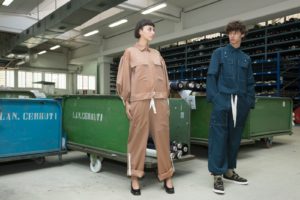
Habitus, Abito, Abitare: Flavia La Rocca, Cittadellarte Fashion B.E.S.T. (with Lanificio F.lli Cerruti as technical sponsor). The items of clothing were made by the social cooperative Sartoria È. Picture taken at Lanificio F.lli Cerruti.
In September, you won the Green Carpet Talent Competition 2019 thanks to a modular dress realised with completely sustainable materials, from the yearn to the fabric, from the accessories to the dyes. What’s the meaning of this prestigious award?
For me, it’s a great acknowledgement of my last six years of determination, passion, sacrifices, failures, joys and achieved objectives. Being sustainable as a small emerging brand has not been at all easy. This award is infusing me with a new energy to carry on more and more determined to build a solid, responsible and ethical brand respecting the planet and the people.

An image of Flavia La Rocca receiving the 2019 Green Carpet Talent Competition Award. From the left: Flavia La Rocca, Sara Sozzani Maino.
What are Flavia La Rocca’s dreams for the future?
I do have quite a few, some pretty ambitious, but I proceed by degrees and try to fulfil them one at a time. Right now, the next step is to launch my e-commerce, in which I can explain what’s behind each item of clothing, detailing who made it, where, and using what type of fabric. The objective is for my pieces to be a conscious buy, conveying the message of a responsible and ethical fashion.

